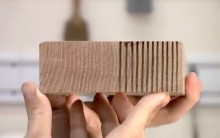4 – Lumber Purchasing and Terminology
Video - November 26, 2006
As just about any woodworker will tell you, your first trip to a hardwood dealer can be quite intimidating. I can honestly say that my first trip was not only intimidating, but confusing and frustrating as well. Poor signage, no prices, and an impatient staff served to make the whole experience less than enjoyable for a woodworking noob. I know I’m not alone here. In this video, I will cover some terminology and topics that will help you be better prepared for your next trip to the lumber yard. Just a few of the topics covered include identifying different types of cuts, estimating board feet, and finding a good hardwood supplier.
Lumber Thickness
1″ boards are referred to as 4/4 (stated as “four quarter”). Rough 4/4 will be anywhere from 13/16″ to 1″ thick. If the board is pre-milled, you can expect it to be close to 3/4″.
2″ boards are referred to as 8/4 (stated as “eight quarter”). Rough 8/4 will be anywhere from 1 13/16 to 2″ thick. If the board is pre-milled, you can expect it to be close to 1 3/4″.
You can also buy lumber in other less common thicknesses like 5/4, 6/4, 12/4, and 16/4.
Keep in mind when purchasing lumber, no matter what the actual thickness is, you’ll be charged at the max rate being 1″ thick for 4/4 stock and 2″ thick for 8/4 stock. You don’t get a discount because the wood is thinner.
Board Feet
Board Feet (BF) is a unit of volume we use to measure hardwoods. Because the wood come in so many lengths, widths and thicknesses, it’s much easier to express their quantity in a unit of volume instead of some sort of linear measurement. Here’s the basic formula:
Length x Width x Thickness / 144 = BF
I like to keep a very common example in mind for rough board foot estimations. A 4/4 board that’s 6″ wide and 8′ long is 4 board feet. Since many boards are cut to this approximate size, you can easily estimate the board feet on the fly by multiplying your number of 4/4 boards by 4.
Types of Cuts
Wood can be cut from a log in numerous ways. Depending on the orientation of the grain, the board may look or behave differently. Some of the most common cuts are listed below and are easily identified by their end grain pattern.

Flatsawn – This is the most common cut you’ll find. The face of the board typically shows a cathedral style grain pattern and the end grain will run horizontally. Most of the seasonal expansion will occur across the width of the board.

Quartersawn – This type of cut is common in a few species where the grain happens to be particularly beautiful, such as white oak. The face grain is usually nice and straight and the end grain is vertical. Because most of the seasonal wood movement occurs over the thickness of quartersawn wood, these boards are usually quite stable. If you’re looking for the most stable stock possible for something like a table top, this is the type of cut you should seek out.

Riftsawn – This is the least common type of cut in my experience. The face grain is dead straight and the end grain appears somewhere between horizontal and vertical. The wood is more stable than flatsawn boards.
With these tips and terminology under your belt, your first trip to the lumber yard won’t be nearly as scary as mine was! Good luck!
Oh and if you are looking for a great way to calculate board feet on the fly, check out the Wood Shop Widget!



